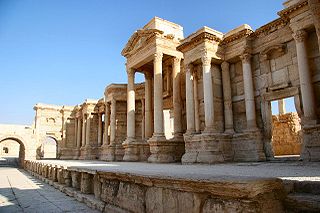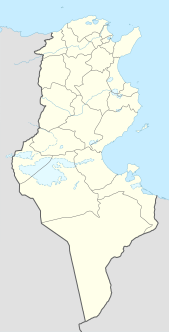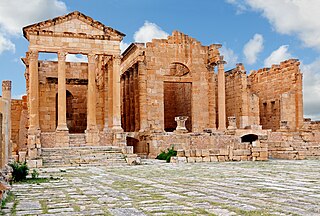Battle of Sufetula can refer to:
- Battle of Sufetula (546 or 547) between Byzantines and Moors
- Battle of Sufetula (647) between Byzantines and Arabs
Battle of Sufetula can refer to:
The Battle of Adrianople, in which Gothic rebels defeated the Eastern Roman Empire, was the main battle of the Gothic War (376–382).

Year 647 (DCXLVII) was a common year starting on Monday of the Julian calendar. The denomination 647 for this year has been used since the early medieval period, when the Anno Domini calendar era became the prevalent method in Europe for naming years.

The Battle of Manzikert was fought between the Byzantine Empire and the Seljuk Empire on 26 August 1071 near Manzikert, theme of Iberia. The decisive defeat of the Byzantine army and the capture of the Emperor Romanos IV Diogenes played an important role in undermining Byzantine authority in Anatolia and Armenia, and allowed for the gradual Turkification of Anatolia. Many of the Turks, who had been travelling westward during the 11th century, saw the victory at Manzikert as an entrance to Asia Minor.

The Battle of the Yarmuk was a major battle between the army of the Byzantine Empire and the Muslim forces of the Rashidun Caliphate. The battle consisted of a series of engagements that lasted for six days in August 636, near the Yarmouk River, along what are now the borders of Syria–Jordan and Syria–Palestine, southeast of the Sea of Galilee. The result of the battle was a complete Muslim victory that ended Byzantine rule in Syria. The Battle of the Yarmuk is regarded as one of the most decisive battles in military history, and it marked the first great wave of early Muslim conquests after the death of Prophet Muhammad, heralding the rapid advance of Islam into the then-Christian Levant.

The Exarchate of Africa was a division of the Byzantine Empire centered around Carthage, Tunisia, that encompassed its possessions on the Western Mediterranean. Ruled by an exarch (viceroy), it was established by the Emperor Maurice in the late 580s and survived until the Muslim conquest of the Maghreb in the late 7th century. It was, along with the Exarchate of Ravenna, one of two exarchates established following the western reconquests under Emperor Justinian I to administer the territories more effectively.

ʿĀmir ibn ʿAbd Allah ibn al-Jarrāḥ, better known as Abū ʿUbayda was a Muslim commander and one of the Companions of the Islamic prophet Muhammad. He is mostly known for being one of the ten to whom Paradise was promised. He remained commander of a large section of the Rashidun Army during the time of the Rashid Caliph Umar and was on the list of Umar's appointed successors to the Rashidun Caliphate.

Sbeitla or Sufetula is a small town in west-central Tunisia. Nearby are the Roman ruins of Sufetula, containing the best preserved Roman forum temples in Tunisia. It was the entry point of the Muslim conquest of North Africa.
Sufetula may refer to:
The Battle of Anchialus refers to three battles between Bulgaria and the Byzantine Empire.

The Muslim conquest of the Levant, also known as the Arab conquest of the Levant, occurred in the first half of the 7th century. This was the conquest of the region known as the Levant or Shaam, later to become the Islamic Province of Bilad al-Sham, as part of the Islamic conquests. Arab Muslim forces had appeared on the southern borders even before the death of Muhammad in 632, resulting in the Battle of Mu'tah in 629, but the real conquest began in 634 under his successors, the Rashidun Caliphs Abu Bakr and Umar ibn Khattab, with Khalid ibn al-Walid as their most important military leader.

The Rashidun Caliphate was the first of the four major caliphates established after the death of the Islamic prophet Muhammad. It was ruled by the first four successive caliphs (successors) of Muhammad after his death in 632 CE. These caliphs are collectively known in Sunni Islam as the Rashidun, or "Rightly Guided" caliphs. This term is not used in Shia Islam, as Shia Muslims do not consider the rule of the first three caliphs legitimate.
Gregory the Patrician was a Byzantine Exarch of Africa. A relative of the ruling Heraclian dynasty, Gregory was fiercely pro-Chalcedonian and led a rebellion in 646 against Emperor Constans II over the latter's support for Monothelism. Soon after declaring himself emperor, he faced an Arab invasion in 647. He confronted the invaders but was decisively defeated and killed at Sufetula. Africa returned to imperial allegiance after his death and the Arabs' withdrawal, but the foundations of Byzantine rule there had been fatally undermined.
Battle of Alexandria, Raid on Alexandria, or Siege of Alexandria may refer to one of these military operations fought in or near the city of Alexandria, Egypt:
Battle of Arcadiopolis may refer to:

Sufes was a town in the late Roman province of Byzacena, which became a Christian bishopric that is included in the Catholic Church's list of titular sees.

The archaeological site of Sbeitla is an archaeological site in Sbeitla, in north-central Tunisia. It represents the Roman ruins of Sufetula, and contains the best preserved Roman forum temples in Tunisia. It was excavated and restored between 1906 and 1921.

The Catholic diocese of Sufetula was an ancient bishopric in the city of Sufetula, on the site of modern Tunisian Sbeitla, in the Roman province of Byzacena.
The Battle of Sufetula took place in 647 between the Arab Muslim forces of the Rashidun Caliphate and the Byzantine Exarchate of Africa.
The Battle of Sufetula was a battle that took place in either late 546 or early 547, at Sufetulain Byzacena, a province of Byzantine Empire, in what is now Tunisia during the Moorish war. It was fought by Byzantine forces led by John Troglita, against Moorish rebels led by Antalas. The battle resulted in a crushing Byzantine victory: the Berbers suffered heavy losses, and the battle-standards lost at the battle of Cillium in 544 were recovered by the Byzantines.